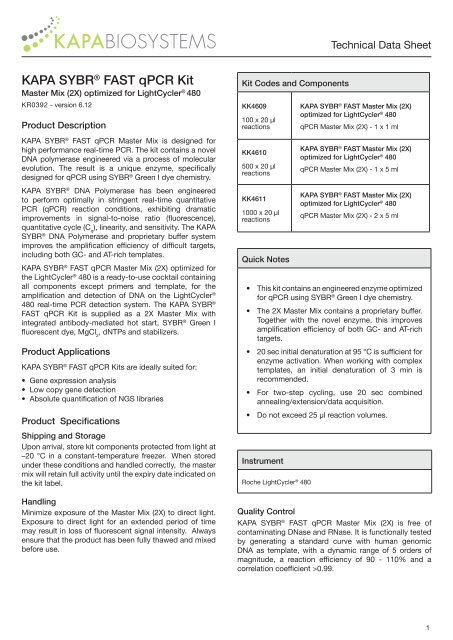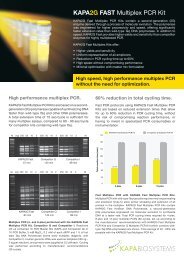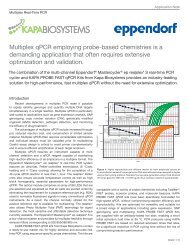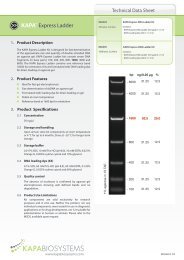KAPA SYBR® FAST qPCR Kit - Kapa Biosystems
KAPA SYBR® FAST qPCR Kit - Kapa Biosystems
KAPA SYBR® FAST qPCR Kit - Kapa Biosystems
You also want an ePaper? Increase the reach of your titles
YUMPU automatically turns print PDFs into web optimized ePapers that Google loves.
<strong>KAPA</strong> SYBR ® <strong>FAST</strong> <strong>qPCR</strong> <strong>Kit</strong><br />
Master Mix (2X) optimized for LightCycler ® 480<br />
KR0392 - version 6.12<br />
Product Description<br />
<strong>KAPA</strong> SYBR ® <strong>FAST</strong> <strong>qPCR</strong> Master Mix is designed for<br />
high performance real-time PCR. The kit contains a novel<br />
DNA polymerase engineered via a process of molecular<br />
evolution. The result is a unique enzyme, specifically<br />
designed for <strong>qPCR</strong> using SYBR ® Green I dye chemistry.<br />
<strong>KAPA</strong> SYBR ® DNA Polymerase has been engineered<br />
to perform optimally in stringent real-time quantitative<br />
PCR (<strong>qPCR</strong>) reaction conditions, exhibiting dramatic<br />
improvements in signal-to-noise ratio (fluorescence),<br />
quantitative cycle (C q ), linearity, and sensitivity. The <strong>KAPA</strong><br />
SYBR ® DNA Polymerase and proprietary buffer system<br />
improves the amplification efficiency of difficult targets,<br />
including both GC- and AT-rich templates.<br />
<strong>KAPA</strong> SYBR ® <strong>FAST</strong> <strong>qPCR</strong> Master Mix (2X) optimized for<br />
the LightCycler ® 480 is a ready-to-use cocktail containing<br />
all components except primers and template, for the<br />
amplification and detection of DNA on the LightCycler ®<br />
480 real-time PCR detection system. The <strong>KAPA</strong> SYBR ®<br />
<strong>FAST</strong> <strong>qPCR</strong> <strong>Kit</strong> is supplied as a 2X Master Mix with<br />
integrated antibody-mediated hot start, SYBR ® Green I<br />
fluorescent dye, MgCl 2 , dNTPs and stabilizers.<br />
Product Applications<br />
<strong>KAPA</strong> SYBR ® <strong>FAST</strong> <strong>qPCR</strong> <strong>Kit</strong>s are ideally suited for:<br />
• Gene expression analysis<br />
• Low copy gene detection<br />
• Absolute quantification of NGS libraries<br />
Product Specifications<br />
Shipping and Storage<br />
Upon arrival, store kit components protected from light at<br />
–20 °C in a constant-temperature freezer. When stored<br />
under these conditions and handled correctly, the master<br />
mix will retain full activity until the expiry date indicated on<br />
the kit label.<br />
Handling<br />
Minimize exposure of the Master Mix (2X) to direct light.<br />
Exposure to direct light for an extended period of time<br />
may result in loss of fluorescent signal intensity. Always<br />
ensure that the product has been fully thawed and mixed<br />
before use.<br />
<strong>Kit</strong> Codes and Components<br />
KK4609<br />
100 x 20 µl<br />
reactions<br />
KK4610<br />
500 x 20 µl<br />
reactions<br />
KK4611<br />
1000 x 20 µl<br />
reactions<br />
Quick Notes<br />
Quality Control<br />
Technical Data Sheet<br />
<strong>KAPA</strong> SYBR ® <strong>FAST</strong> Master Mix (2X)<br />
optimized for LightCycler ® 480<br />
<strong>qPCR</strong> Master Mix (2X) - 1 x 1 ml<br />
<strong>KAPA</strong> SYBR ® <strong>FAST</strong> Master Mix (2X)<br />
optimized for LightCycler ® 480<br />
<strong>qPCR</strong> Master Mix (2X) - 1 x 5 ml<br />
<strong>KAPA</strong> SYBR ® <strong>FAST</strong> Master Mix (2X)<br />
optimized for LightCycler ® 480<br />
<strong>qPCR</strong> Master Mix (2X) - 2 x 5 ml<br />
• This kit contains an engineered enzyme optimized<br />
for <strong>qPCR</strong> using SYBR ® Green I dye chemistry.<br />
• The 2X Master Mix contains a proprietary buffer.<br />
Together with the novel enzyme, this improves<br />
amplification efficiency of both GC- and AT-rich<br />
targets.<br />
• 20 sec initial denaturation at 95 °C is sufficient for<br />
enzyme activation. When working with complex<br />
templates, an initial denaturation of 3 min is<br />
recommended.<br />
• For two-step cycling, use 20 sec combined<br />
annealing/extension/data acquisition.<br />
• Do not exceed 25 µl reaction volumes.<br />
Instrument<br />
Roche LightCycler ® 480<br />
<strong>KAPA</strong> SYBR ® <strong>FAST</strong> <strong>qPCR</strong> Master Mix (2X) is free of<br />
contaminating DNase and RNase. It is functionally tested<br />
by generating a standard curve with human genomic<br />
DNA as template, with a dynamic range of 5 orders of<br />
magnitude, a reaction efficiency of 90 - 110% and a<br />
correlation coefficient >0.99.<br />
1
<strong>KAPA</strong> SYBR ® <strong>FAST</strong> <strong>qPCR</strong> <strong>Kit</strong><br />
Master Mix (2X) optimized for LightCycler ® 480<br />
<strong>KAPA</strong> SYBR ® <strong>FAST</strong> <strong>qPCR</strong> Protocol<br />
Any existing <strong>qPCR</strong> assay performed efficiently using<br />
standard cycling conditions may be converted to a<br />
Fast <strong>qPCR</strong> assay with <strong>KAPA</strong> SYBR ® <strong>FAST</strong> <strong>qPCR</strong> <strong>Kit</strong>s.<br />
Typically, minimal re-optimization of reaction parameters<br />
is required.<br />
This protocol is intended for use with the LightCycler ® 480<br />
real-time PCR detection system.<br />
Step 1: Set up the <strong>qPCR</strong> reaction<br />
• Ensure all reaction components are properly thawed<br />
and mixed.<br />
• Calculate the required volumes of each component<br />
based on the following table:<br />
*Final MgCl 2 concentration is 2.5 mM.<br />
• Prepare a PCR master mix consisting of the<br />
appropriate volumes of <strong>KAPA</strong> SYBR ® <strong>FAST</strong> <strong>qPCR</strong><br />
Master Mix (2X), PCR-grade water and any other<br />
component (e.g. template or primers) that is common<br />
to all or a subset of the reactions to be performed.<br />
Ensure reaction components are mixed properly.<br />
Step 2: Set up the plate<br />
• Transfer the appropriate volumes of PCR master mix,<br />
template and primers to each well of a PCR tube/<br />
plate.<br />
• Cap or seal the reaction tube/plate and centrifuge<br />
briefly.<br />
2<br />
Components<br />
Final<br />
concentration<br />
Per 20 µl rxn<br />
PCR-grade water Up to 20 µl<br />
<strong>KAPA</strong> SYBR ® <strong>FAST</strong><br />
<strong>qPCR</strong> Master Mix (2X)*<br />
1X 10 μl<br />
Forward Primer (10 µM) 200 nM 0.4 μl<br />
Reverse Primer (10 µM) 200 nM 0.4 μl<br />
Template DNA (
<strong>KAPA</strong> SYBR ® <strong>FAST</strong> <strong>qPCR</strong> <strong>Kit</strong><br />
Master Mix (2X) optimized for LightCycler ® 480<br />
Important Parameters<br />
Template<br />
High concentrations of template may increase background<br />
fluorescence and reduce linearity of standard curves. For<br />
optimal quantitative results, use up to 20 ng of genomic<br />
DNA or plasmid DNA per 20 µl reaction (for smaller<br />
volumes, the amount of template should be decreased<br />
proportionally). For two-step RT-PCR, use either undiluted<br />
or diluted cDNA generated from up to 1 µg of total RNA.<br />
The volume of the cDNA (reverse transcription reaction<br />
product) should not exceed 10% of the final PCR volume<br />
(e.g. for a 20 µl <strong>qPCR</strong> reaction, use up to 2.0 µl of undiluted<br />
cDNA).<br />
Primers<br />
Careful primer design and purification (HPLC-purified<br />
primers are recommended) will minimize loss in<br />
sensitivity due to nonspecific amplification. This effect<br />
becomes more prominent at low target concentrations.<br />
To maximize the sensitivity of the assay, use the lowest<br />
primer concentration determined not to compromise<br />
reaction efficiency (50 - 400 nM of each primer). For<br />
optimal results, design primers that amplify PCR products<br />
60 - 400 bp in length. Use appropriate primer design<br />
software to design primers with a melting temperature (T m )<br />
of approximately 60 °C, to take advantage of two-step<br />
cycling. If performing qRT-PCR, we recommend designing<br />
primers specifically for amplification of cDNA derived<br />
from mRNA. This prevents amplification of contaminating<br />
genomic DNA and inaccurate quantification of mRNA.<br />
<strong>KAPA</strong> SYBR ® DNA Polymerase<br />
<strong>KAPA</strong> SYBR ® DNA Polymerase is an engineered version of<br />
Taq DNA polymerase, designed specifically for real-time<br />
PCR using SYBR Green I chemistry. <strong>KAPA</strong> SYBR ® DNA<br />
Polymerase displays no enzymatic activity at ambient<br />
temperature. This prevents the formation of misprimed<br />
products and primer-dimers during reaction setup, prior<br />
to the first denaturation step, and results in high PCR<br />
specificity and accurate quantification. The enzyme is<br />
activated during the initial denaturation step of the PCR.<br />
The activation of the enzyme is complete after 20 sec;<br />
however, complex targets may require up to 3 min for<br />
optimal denaturation. The hot start feature obviates the<br />
need to cool reactions during setup.<br />
SYBR ® Green I<br />
<strong>KAPA</strong> SYBR ® <strong>FAST</strong> <strong>qPCR</strong> Master Mix (2X) contains an<br />
elevated, optimized concentration of the fluorescent dye,<br />
SYBR ® Green I. High signal intensities are achieved as<br />
a result of increased tolerance to high concentrations<br />
of SYBR ® Green I by the engineered <strong>KAPA</strong> SYBR ® DNA<br />
Polymerase. SYBR ® Green I binds all double-stranded<br />
DNA molecules, emitting a fluorescent signal on binding.<br />
Magnesium chloride<br />
The <strong>KAPA</strong> SYBR ® <strong>FAST</strong> <strong>qPCR</strong> Master Mix contains an<br />
optimized MgCl 2 concentration. It is highly unlikely that<br />
additional MgCl 2 will improve reaction efficiency or<br />
specificity.<br />
Note to Purchaser: Limited License<br />
Technical Data Sheet<br />
Certain applications of this product are covered by patents issued to<br />
parties other than <strong>Kapa</strong> <strong>Biosystems</strong> and applicable in certain countries.<br />
Purchase of this product does not include a license to perform any such<br />
applications. Users of this product may therefore be required to obtain a<br />
patent license depending upon the particular application and country in<br />
which the product is used.<br />
Use of this product is covered by one or more of the following US<br />
patents and corresponding patent claims outside the US: 5,994,056,<br />
6,171,785, and 5,928,907 (claim numbers 12-24, 27-28). The purchase<br />
of this product includes a limited, non-transferable immunity from suit<br />
under the foregoing patent claims for using only this amount of product<br />
for the purchaser’s own internal research. No right under any other<br />
patent claim (such as apparatus or system claims in US Patent No.<br />
6,814,934) and no right to perform commercial services of any kind,<br />
including without limitation reporting the results of purchaser’s activities<br />
for a fee or other commercial consideration, is conveyed expressly,<br />
by implication, or by estoppel. This product is for research use only.<br />
Diagnostic uses under Roche patents require a separate license from<br />
Roche. Further information on purchasing licenses may be obtained by<br />
contacting the Director of Licensing, Applied <strong>Biosystems</strong>, 850 Lincoln<br />
Centre Drive, Foster City, California 94404, USA.<br />
This product is provided under an agreement between Life Technologies<br />
Corporation. and <strong>Kapa</strong> <strong>Biosystems</strong> Inc., and the manufacture, use, sale<br />
or import of this product is subject to one or more of U.S. Patent Nos.<br />
5,436,134; 5,658,751 and corresponding international equivalents,<br />
owned by Life Technologies Corporation. The purchase of this product<br />
conveys to the buyer the non-transferable right to use the purchased<br />
amount of the product and components of the product in research<br />
conducted by the buyer, where such research does not include<br />
testing, analysis or screening services for any third party in return for<br />
compensation on a per test basis. The buyer cannot sell or otherwise<br />
transfer (a) this product (b) its components or (c) materials made using<br />
this product or its components to a third party or otherwise use this<br />
product or its components or materials made using this product or its<br />
components for Commercial Purposes. Commercial Purposes means<br />
any activity by a party for consideration and may include, but is not<br />
limited to: (1) use of the product or its components in manufacturing; (2)<br />
use of the product or its components to provide a service, information,<br />
or data; (3) use of the product or its components for therapeutic,<br />
diagnostic or prophylactic purposes; or (4) resale of the product or<br />
its components, whether or not such product or its components are<br />
resold for use in research. For information on purchasing a license to<br />
this product for purposes other than research, contact Life Technologies<br />
Corporation, 5791 Van Allen Way, Carlsbad, CA 92008 USA or<br />
outlicensing@lifetech.com.<br />
Licensed under U.S. Patent nos. 5,338,671 and 5,587,287 and<br />
corresponding patents in other countries.<br />
The purchase of this product includes a limited, non-transferable license<br />
under specific claims of U.S. Patent Nos. 6,174,670, 6,569,627 and<br />
5,871,908, owned by the University of Utah Research Foundation or<br />
Evotec <strong>Biosystems</strong> GmbH and licensed to Idaho Technology, Inc. and<br />
Roche Diagnostics GmbH, to use only the enclosed amount of product<br />
according to the specified protocols. No right is conveyed, expressly,<br />
by implication, or by estoppel, to use any instrument or system under<br />
any claim of U.S. Patent Nos. 6,174,670, 6,569,627 and 5,871,908,<br />
other than for the amount of product contained herein.<br />
SYBR ® is a registered trademark of Life Technologies Corporation. LightCycler ® is<br />
a registered trademark of Roche Diagnostics GmbH.<br />
3
<strong>KAPA</strong> SYBR ® <strong>FAST</strong> <strong>qPCR</strong> <strong>Kit</strong><br />
Master Mix (2X) optimized for LightCycler ® 480<br />
Troubleshooting<br />
4<br />
Symptoms Possible Causes Solutions<br />
Positive signal in no-template<br />
control (NTC)<br />
Presence of secondary,<br />
nonspecific peak in melt<br />
curve of sample<br />
Reasons for a positive signal in a NTC<br />
and/or nonspecific amplifcation are often due<br />
to multiple factors that include:<br />
1. Contamination<br />
2. Primer-dimer formation due to:<br />
• Incorrect cycling protocol<br />
• Sub-optimal primer annealing temperature<br />
(often due to differences between<br />
<strong>qPCR</strong> systems)<br />
• Primer and/or template degradation<br />
(always store and dilute primers and<br />
template in 10 mM Tris-HCl, pH 8.0 - 8.5<br />
and not in PCR-grade water)<br />
• Sub-optimal primer synthesis<br />
• Sub-optimal primer design<br />
For support please contact: support@kapabiosystems.com<br />
Technical Data Sheet<br />
Perform melt curve analysis (or run <strong>qPCR</strong><br />
products on a gel) to determine if the product<br />
is specific or nonspecific (primer dimer).<br />
If the NTC contains a specific product, the<br />
assay is contaminated:<br />
• Discard all reagents, clean all pipettes<br />
and surfaces and prepare fresh stocks of<br />
primer, etc.<br />
Note: The increased sensitivity of <strong>KAPA</strong><br />
SYBR ® <strong>FAST</strong> <strong>qPCR</strong> <strong>Kit</strong>s may result in the<br />
detection of low levels of contamination in<br />
assays considered contaminant-free when<br />
using competitor kits containing wild-type Taq<br />
DNA polymerase.<br />
If the NTC and/or sample contains nonspecific<br />
product, assay optimization may be required:<br />
• 30 sec combined annealing/extension<br />
time is recommended for most assays.<br />
Longer times may result in nonspecific<br />
amplification.<br />
• Increase the combined annealing/<br />
extension temperature in increments<br />
of 3 ºC.<br />
• Decrease primer concentration.<br />
• Resynthesize or redesign primers. HPLC<br />
purified primers are recommended for low<br />
copy number detection, and often results<br />
in reduced primer-dimer formation.<br />
Low fluorescence intensity Incorrect handling SYBR ® Green I dye is light sensitive; avoid<br />
exposure to light and repeated freeze-thaw<br />
cycles. Always thaw and mix solutions<br />
thoroughly before use.<br />
Melting temperature of specific<br />
product is different from<br />
competitor kit<br />
Differences in the buffer composition (e.g. salt<br />
concentration) of <strong>qPCR</strong> master mixes<br />
Differences in master mix formulation may effect<br />
the melting temperature of the product slightly.<br />
A particular DNA fragment will melt at a higher<br />
temperature in a reaction buffer containing a<br />
higher salt concentration.<br />
Boston, Massachusetts, United States.<br />
Int. Tel: +1 781 497 2933 Tel: +1 855 <strong>KAPA</strong> BIO<br />
Fax: +1 781 497 2934<br />
Email: sales@kapabiosystems.com<br />
Cape Town, South Africa<br />
Tel: +27 21 448 8200 Fax: +27 21 448 6503<br />
Email: sales@kapabiosystems.com










